One problem though. I ordered the file for the wrong Samuel Fisher ;-(
Of course, I didn't know that until I opened the package from NARA. I had searched the Civil War Pension Cards on Footnote. I saw the card for Samuel Fisher that had served in Co. A 9th Regiment, Kansas Cavalry and ordered the file.
Anyway, after I got the NARA package I located the pension card for the other Samuel Fisher, the one I really wanted. The weird thing is that at the bottom of both of their pension cards it makes reference to the "other" Samuel. I just didn't see it. Or else I ignored the information. Not only that, the one I wanted also included his date of death, which matched my information. Sure wish I had clicked through a few more cards though. . .
But the government got them mixed up back in 1894, so maybe I shouldn't feel so bad. The moral of the story is don't assume there is only one person with the right name in the right unit (even though its wrong), or in the right location. I still haven't ordered the file on the "right" Samuel Fisher, primarily because of the cost. (I wonder how long it will be before Footnote has the Civil War Pension files online?)
 On October 5, 1891 the Samuel Fisher who resided at Alfred in Douglas County, Kansas (the one who is my relative) filed an application (1064047) for pension based on his service in Co. A of the 9th Regiment Kansas Infantry for which he received pension certificate 1028602. Card shown above, image from footnote.
On October 5, 1891 the Samuel Fisher who resided at Alfred in Douglas County, Kansas (the one who is my relative) filed an application (1064047) for pension based on his service in Co. A of the 9th Regiment Kansas Infantry for which he received pension certificate 1028602. Card shown above, image from footnote. On March 3, 1894 the Samuel Fisher who resided at Osceola, Missouri filed application 1260663 based on his service in Co. B 9th Reg't Provisional Mo. Mil. [Missouri Militia]. He received pension certificate 890462 that was based on the service of the Kansas Samuel. Image from footnote.
On March 3, 1894 the Samuel Fisher who resided at Osceola, Missouri filed application 1260663 based on his service in Co. B 9th Reg't Provisional Mo. Mil. [Missouri Militia]. He received pension certificate 890462 that was based on the service of the Kansas Samuel. Image from footnote.If anyone out there is related to the Samuel Fisher described below, I'd be happy to send the file to you. . . it's about 100 pages.
Samuel Fisher resided in Lowery City, St. Clair, Missouri when he filed his application in August 1894. He was 67 years old and asked for a pension due to rheumatism and general debility. He stated that he had served in three different regiments of Missouri Militia. His original declaration also stated he served in the 9th Kansas Cavalry though he later said he didn't know how that got included.
On June 7th 1900, Missouri Samuel was living in Trenton, Hitchcock county, Nebraska. A special examination was held on that date. In his deposition, Samuel states that he was 74 years old on the 17th day of last March. He is a farmer and resides about five miles southeast of Trenton. He was born in Montgomery County, Kentucky near Mt. Sterling. In the fall of 1859 he moved to Grundy County, Missouri. Twelve years ago he moved to St. Clair, Missouri and in January 1899 moved to Hitchcock County, Nebraska.
He served six months in Co. E 9th Mo. Provisional Cavalry. The regiment was on duty at Chillicothe, Missouri doing guard duty and moving around Missouri guarding block houses and rail roads. In 1863 he was called to duty in Co. D 2nd Batt'n Mo. S.M. Cav. and also served in Co. E 8th Reg't Mo. State Militia. He states that he never served in Co. A 9th Kansas Cavalry. On August 9, 1894 he received a pension of $10 and saw that his certificate was for Co. A 9th Kans. Cav. and thought it was just a mistake. It was noticed when he was changed to the Des Moines, Iowa agency a short time ago.
He goes on to say that he has been married twice. First to Mary Dennis in Bass County, Kentucky in March of 1853. He thinks she died in 1872 in Grundy County, Missouri. He next married his present wife, Elizabeth Blue, on January 20, 1880 in Livingston County, Missouri. She had been married once before to John Mason who "disappeared and never could be found and my wife obtained a divorce from him about 1878 or 1879".
Samuel and Elizabeth have three children under the age of 16 years (dates recorded in the family bible): Otto Fisher, born Oct. 9, 1884; Everett Fisher, born Oct. 9, 1886; Edna M. Fisher, born Nov. 20, 1890. Witnesses to the deposition were Elizabeth A. Fisher and Richard Fisher.
I wish my ancestors were as easy to find in the census records as this Samuel was. Of course, it helps to know where he was. . .
In 1850, Samuel Fisher was a 22 year old farmer living in Division 2, Bath County, Kentucky. In his household was Mary Fisher, age 20; Levi Fisher, age 3/12; and John J. Fisher, age 10. All were born in Kentucky.
Samuel Fisher was 32 years old and living in Trenton township, Grundy county, Missouri in 1860. He was a farmer with a personal estate valued at $250. In the household was Mary, age 30; Martha, 8; Lydia, 5; Levi, 10; Moses, 3; and Moses, age 44, a farmer with real estate valued at $4000 and a personal estate of $500. Everyone except Martha was born in Kentucky, she was born in Indiana.
In 1870, Samuel Fisher was found in Liberty Township, Grundy County, Missouri. He was 44 years old, a farmer, real estate valued at $1600 and a personal estate valued at $900. He had been born in Kentucky. There were six children listed in the household, no wife: Martha, age 18, born Indiana; Lyddia, 15, born Kentucky; Moses, 12, born Kentucky; Mary, 9; John, 6; and Jesse J., 3. The last three were born in Missouri.
Samuel Fisher, age 53, was found in Lincoln Township, Grundy County, Missouri in 1880. He was a farmer, born in Kentucky. Listed with him was his 19 year old daughter, Mary M. and two sons, John R., age 15 and Jesse J., age 12. Also a 13 year old female with no relationship given - Annie Mason, age 13. His children and Annie were all born in Missouri.
The 1900 census for Grant Precinct, Hitchcock County, Nebraska shows Samuel Fisher, age 73, born June 1826 in Missouri, married 28 years, his parents were born in Kentucky, and he was a farmer. Listed in the household are: Betsey R., wife, born June 1880, age 59, had 12 children with 7 living; Richard, son, born Nov 1882, age 17; Otto, son born Oct 1885, age 14; Everett, daugt [sic, sex is male], born Oct 1886, age 13; and Edna, daughter, born Nov 1889, age 10. Betsey and the children were all born in Missouri.
Now, back to the pension file: In the letter submitted by the special examiner it states that Samuel "is drawing pension based upon the service of another man, although it is the service stated in his original declaration. How he came to hit upon that service is not clear, but there is nothing at this state of the investigation that indicates design or criminal intent."
It was recommended that his claim should be put on hold until it could be determined if the pensioner "was in the U. S. Service or not." For possible use in identification, a tintype picture of the man, taken about 20 years ago, was obtained, which is to be returned to the claimant. The examiner goes on to say "I do not put much reliance upon some of his statements regarding his services as he seemed to be somewhat muddled on this question." The examiner also recommended that the files of the two Samuel Fisher's should be separated to help eliminate future confusion. (Duh!)
On November 17, 1900 a letter was sent to Samuel Fisher at Trenton, Nebraska informing him that he would be dropped from the pension rolls because he was not the same Samuel Fisher who had served in Company A of the 9th Regiment Kansas Cavalry. He was officially dropped from the rolls on January 7, 1901 though he continued his battle for another four years. On October 11, 1905 his application was rejected "for the reason that the claimant has no title to pension. . . he did not render ninety days military service during the War of the Rebellion."
 Every time we travel up and down the east coast we crack up at the 999 billboards advertising South of the Border. For the longest time we only knew of this place from driving by it. At some point we actually stopped and stayed at the campground. To say this place is bizarre is truly understatement.
Every time we travel up and down the east coast we crack up at the 999 billboards advertising South of the Border. For the longest time we only knew of this place from driving by it. At some point we actually stopped and stayed at the campground. To say this place is bizarre is truly understatement. Then as you look around, it seems dated and a bit strange.
Then as you look around, it seems dated and a bit strange. If you look closer, you can see what begins to be really strange.
If you look closer, you can see what begins to be really strange. When we stayed here, Auburn joked that it looked like the set to a really cheesy horror flick. The fact we were the only people we saw, beyond the workers, made it seem even more that way. There is just no other place like this unique little complex.
When we stayed here, Auburn joked that it looked like the set to a really cheesy horror flick. The fact we were the only people we saw, beyond the workers, made it seem even more that way. There is just no other place like this unique little complex. The last time when we visited, I forgot to snap any pictures. I'm glad I remembered this time.
The last time when we visited, I forgot to snap any pictures. I'm glad I remembered this time. I don't know, Ava. I just don't know!
I don't know, Ava. I just don't know! Living the life in SC!
Living the life in SC!









 And my favorite barn that we've seen so far. It wasn't the prettiest, but I loved its endurance and character!
And my favorite barn that we've seen so far. It wasn't the prettiest, but I loved its endurance and character!  And while I'm writing, can I say how good it is to be back? When we were in PA, we had no cell phone service and very limited internet. As in, I could not even read Pioneer Woman's blog. So I didn't bother doing much posting there. I'll have to see if I can go back and cover what we did see and do there sometime.
And while I'm writing, can I say how good it is to be back? When we were in PA, we had no cell phone service and very limited internet. As in, I could not even read Pioneer Woman's blog. So I didn't bother doing much posting there. I'll have to see if I can go back and cover what we did see and do there sometime. Cycling past the Boston Public Garden last night, it looked so magical that we had to stop and take some night pictures. When people see pictures like this, they often assume that the wild colours are some sort of special effect - infrared photography or
Cycling past the Boston Public Garden last night, it looked so magical that we had to stop and take some night pictures. When people see pictures like this, they often assume that the wild colours are some sort of special effect - infrared photography or  To take a night picture, the camera is placed on a stationary surface and the photographer sets a long exposure time (the duration for which the camera's shutter remains open). To give you a point of comparison, daytime pictures are typically taken with an exposure time of less than 1/100th of a second. Night pictures are taken with with an exposure time of 5 full seconds or longer.
To take a night picture, the camera is placed on a stationary surface and the photographer sets a long exposure time (the duration for which the camera's shutter remains open). To give you a point of comparison, daytime pictures are typically taken with an exposure time of less than 1/100th of a second. Night pictures are taken with with an exposure time of 5 full seconds or longer.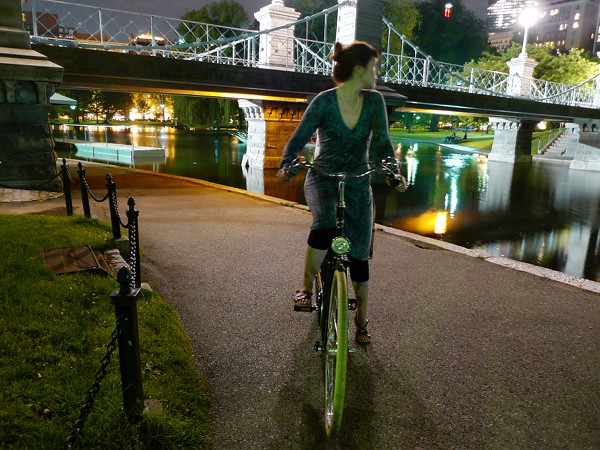 In order for long exposure pictures to work, both camera and subject must remain completely still - or else every movement is recorded as a motion blur. Facial expressions are the hardest to keep still and features tends to come out blurry. Bicycles on the other hand, are quite capable of standing motionless and are very patient too - which makes them perfect models for night photography.
In order for long exposure pictures to work, both camera and subject must remain completely still - or else every movement is recorded as a motion blur. Facial expressions are the hardest to keep still and features tends to come out blurry. Bicycles on the other hand, are quite capable of standing motionless and are very patient too - which makes them perfect models for night photography.  Anne learning to snowplow under beautiful skies
Anne learning to snowplow under beautiful skies Sabrina and Anne coming up a hill
Sabrina and Anne coming up a hill Happy New Year!
Happy New Year! This dragonfly took refuge on our back porch during the rainstorm. We don't normally have the really bigs ones here at the house but see them down by the river.
This dragonfly took refuge on our back porch during the rainstorm. We don't normally have the really bigs ones here at the house but see them down by the river.

 The tunnel
The tunnel The Tooth, Denny, Snoqualmie Peaks
The Tooth, Denny, Snoqualmie Peaks


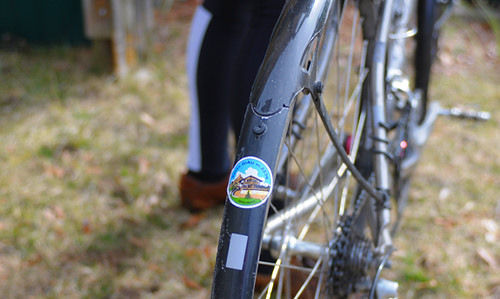
 The Stronghold House as seen from across the the canyon, from the south side.
The Stronghold House as seen from across the the canyon, from the south side. These are the same two buildings in the previous photo, taken from a slightly different angle. Using the zoom distorts and compresses the view somewhat.
These are the same two buildings in the previous photo, taken from a slightly different angle. Using the zoom distorts and compresses the view somewhat. Two towers, looking northwest.
Two towers, looking northwest. The same two towers, looking northeast.
The same two towers, looking northeast. Detail showing the stonework.
Detail showing the stonework. Hovenweep House, the largest structure in the area, along with several outbuildings. As seen from the south side of the canyon.
Hovenweep House, the largest structure in the area, along with several outbuildings. As seen from the south side of the canyon. Hovenweep House, on the edge of the canyon. Looking to the east.
Hovenweep House, on the edge of the canyon. Looking to the east. The Square Tower. Perched on a boulder, at the bottom of the west end of the canyon.
The Square Tower. Perched on a boulder, at the bottom of the west end of the canyon. Ruins Canyon, looking east. The two towers are just below the rim of the canyon near the center of the picture. Several other structures dot the landscape, almost blending in with the boulders.
Ruins Canyon, looking east. The two towers are just below the rim of the canyon near the center of the picture. Several other structures dot the landscape, almost blending in with the boulders.
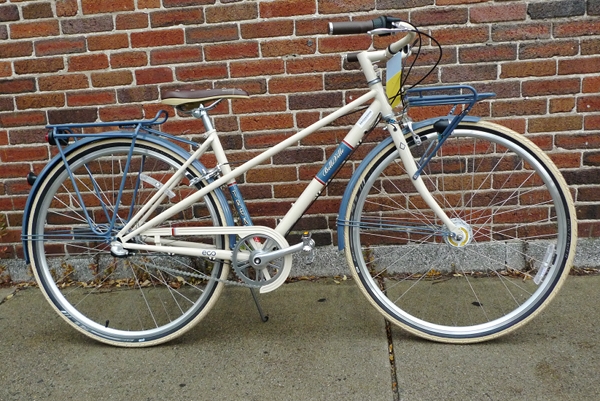 Lately, readers have been asking about the Trek Belleville WSD mixte. It has been out for about a year and looks promising in pictures, but what is it like in person? I had noticed this bicycle earlier at one of my local bike shops - theWheelworks in Somerville, MA - and recently had a chance to try it.
Lately, readers have been asking about the Trek Belleville WSD mixte. It has been out for about a year and looks promising in pictures, but what is it like in person? I had noticed this bicycle earlier at one of my local bike shops - theWheelworks in Somerville, MA - and recently had a chance to try it.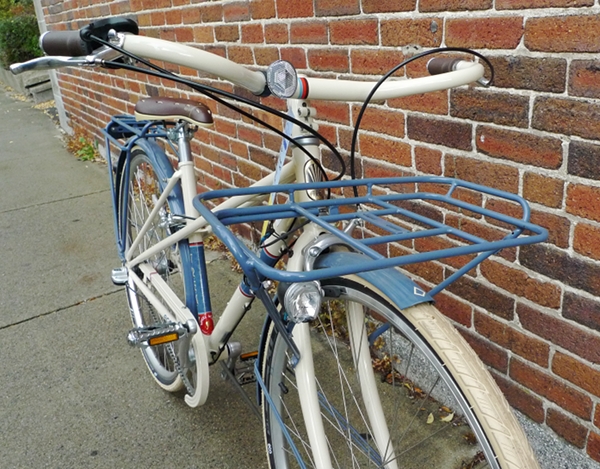 The Trek Bellevillemixte is a "real" mixte - in the sense that it is built with twin lateral stays that extend from the head tube to the rear dropouts. The bicycle reflects the ideas of the French constructeurs (or, more likely, the contemporary builders who emulatethe original constructeurs) in that it is fully equipped with fenders, front and rear racks, and dynamo-powered lighting. However, unlike classic mixtes with their elegant lines and lugged steel construction, theTrek Belleville's frameis made of a strangely thick, welded cromoly tubing. The tubing is so chunky in fact, that I was certain the bike was aluminum until I was corrected. In industry photos the chunkiness is easily disguised with good lighting and careful choice of angles. But in person, the bicycle looks like what it is: a somewhat clumsy mass-produced bike fitted with some admittedly impressive extras. Trek also promotes the "eco-design" of this model, which you can read about here.
The Trek Bellevillemixte is a "real" mixte - in the sense that it is built with twin lateral stays that extend from the head tube to the rear dropouts. The bicycle reflects the ideas of the French constructeurs (or, more likely, the contemporary builders who emulatethe original constructeurs) in that it is fully equipped with fenders, front and rear racks, and dynamo-powered lighting. However, unlike classic mixtes with their elegant lines and lugged steel construction, theTrek Belleville's frameis made of a strangely thick, welded cromoly tubing. The tubing is so chunky in fact, that I was certain the bike was aluminum until I was corrected. In industry photos the chunkiness is easily disguised with good lighting and careful choice of angles. But in person, the bicycle looks like what it is: a somewhat clumsy mass-produced bike fitted with some admittedly impressive extras. Trek also promotes the "eco-design" of this model, which you can read about here. 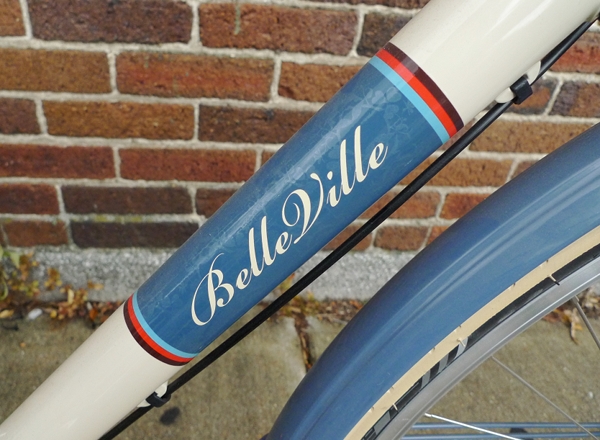 I think that one of the most successful aspects of theTrek Bellevilleis the colour scheme and graphics. We like to fool ourselves into thinking that this stuff does not influence us, but it does. The slate-blue and cream colour combination with subtle red accents is harmonious, beautiful, and nostalgic. It dominates the aesthetics of the bicycle, distracting the eye from its less appealing aspects.
I think that one of the most successful aspects of theTrek Bellevilleis the colour scheme and graphics. We like to fool ourselves into thinking that this stuff does not influence us, but it does. The slate-blue and cream colour combination with subtle red accents is harmonious, beautiful, and nostalgic. It dominates the aesthetics of the bicycle, distracting the eye from its less appealing aspects. Trek also used a vintage headbadge for the Belleville, which goes nicely with the classic theme.
Trek also used a vintage headbadge for the Belleville, which goes nicely with the classic theme.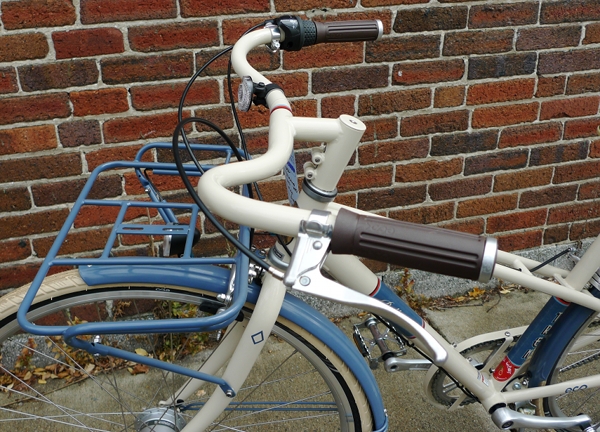 The Trek Belleville uses a threadless stem and Porteur-style handlebars. Both the stem and the handlebars are painted body colour, which is nice. A Porteur-style front rack is attached to the fork.
The Trek Belleville uses a threadless stem and Porteur-style handlebars. Both the stem and the handlebars are painted body colour, which is nice. A Porteur-style front rack is attached to the fork.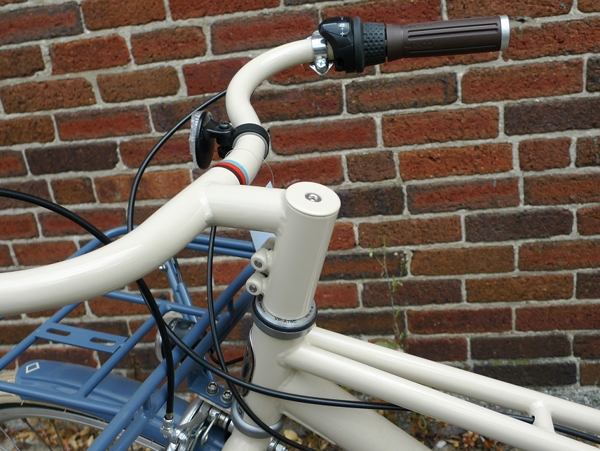 Close-up of the stem, grips, shifter and the points where the lateral stays attach to the head tube. While I do not normally like threadless stems and integrated handlebars, I think here the look is appealing. However, the design makes it impossible to adjust stem height and the angle of the handlebars, which is problematic.
Close-up of the stem, grips, shifter and the points where the lateral stays attach to the head tube. While I do not normally like threadless stems and integrated handlebars, I think here the look is appealing. However, the design makes it impossible to adjust stem height and the angle of the handlebars, which is problematic.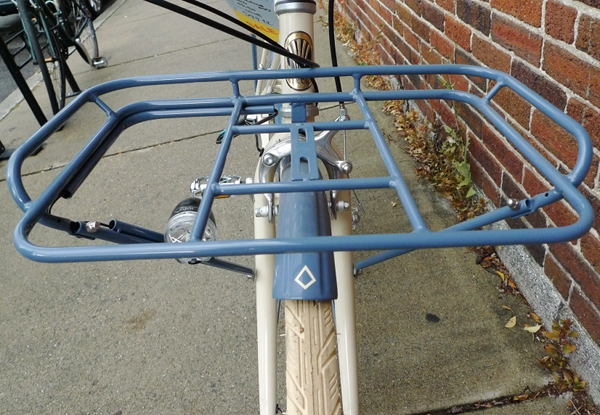 The front rack is quite elegant, as well as smoothly integrated with the body of the bike. The tires are Bontrager, cream with black sidewalls.
The front rack is quite elegant, as well as smoothly integrated with the body of the bike. The tires are Bontrager, cream with black sidewalls. The rear rack is nice as well. I don't remember the weight rating, but it was considerable. One thing I noticed, is that the attachment points are set back from the rear dropouts - presumably because the chainstays are otherwise not long enough to accommodate a rack?
The rear rack is nice as well. I don't remember the weight rating, but it was considerable. One thing I noticed, is that the attachment points are set back from the rear dropouts - presumably because the chainstays are otherwise not long enough to accommodate a rack? TheTrek Bellevilleis fitted with an internally geared hub (Shimano Nexus 3-speed), caliper brakes, a decent-looking crankset, touring-style pedals, and a body-coloured chainguard.
TheTrek Bellevilleis fitted with an internally geared hub (Shimano Nexus 3-speed), caliper brakes, a decent-looking crankset, touring-style pedals, and a body-coloured chainguard.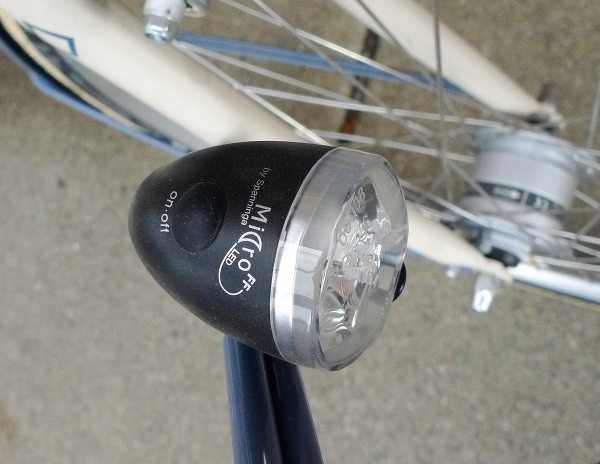 The front dynamo hub is a Shimano (I did not see the model name), and the lights used are Spanniga. The headlight is a Spanniga Micro, mounted on right stay of the front rack.
The front dynamo hub is a Shimano (I did not see the model name), and the lights used are Spanniga. The headlight is a Spanniga Micro, mounted on right stay of the front rack. The tail light is a Spanniga Eclipse, attached to the rear rack. I have not tried the lights, as it was daytime, but I have heard good things about these models.
The tail light is a Spanniga Eclipse, attached to the rear rack. I have not tried the lights, as it was daytime, but I have heard good things about these models.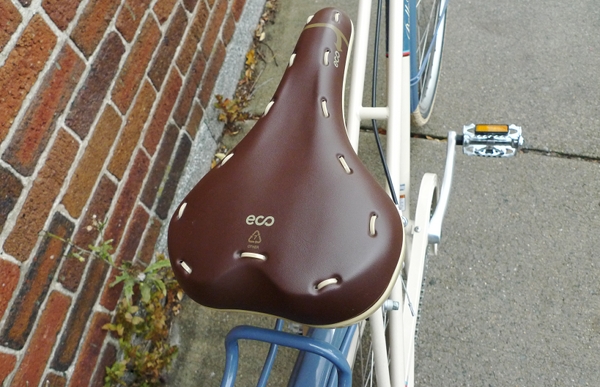 The saddle has a faux-handsewn leather look to it and feels like a typical padded vinyl saddle. I have read that it was designed to be disassembled and recycled after use, though I am not clear on the details.
The saddle has a faux-handsewn leather look to it and feels like a typical padded vinyl saddle. I have read that it was designed to be disassembled and recycled after use, though I am not clear on the details.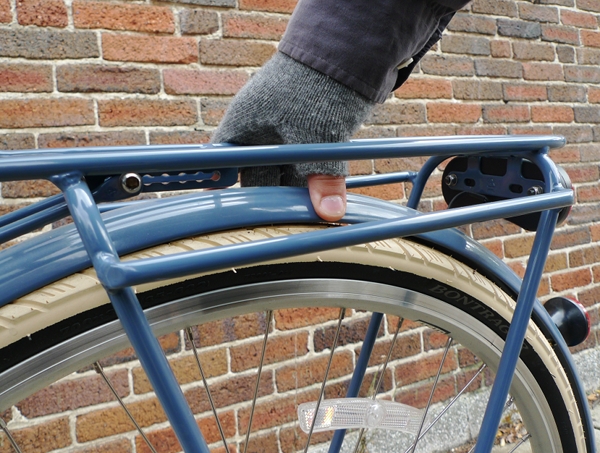 I would estimate the weight of the Bellevillemixte around 35lbs. Very reasonable, considering the steel tubing and all the extras.
I would estimate the weight of the Bellevillemixte around 35lbs. Very reasonable, considering the steel tubing and all the extras. 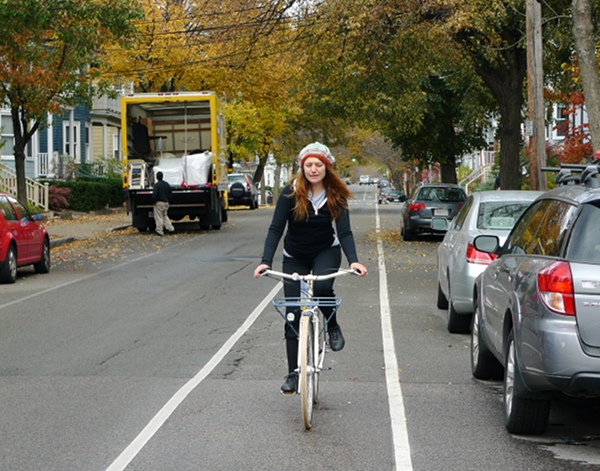 I test-rode the Trek Belleville mixte briefly, and I apologise for my disgraceful "salmoning" - it was only done for the photo. As reflected in the picture, the first thing I noted was the unusually generous width of the handlebars - I almost felt as if I were holding the edges of a hula hoop. Maybe this was the cause of the strange feel to the steering, because I found the front end to be "aloof" - almost as if it was receiving its steering instructions via a third party rather than from me directly. I wonder whether it would handle differently with a front load, but that is not something I was able to test. Otherwise, the ride felt okay - with the exception perhaps of too much pressure on my hands despite the upright handlebars.
I test-rode the Trek Belleville mixte briefly, and I apologise for my disgraceful "salmoning" - it was only done for the photo. As reflected in the picture, the first thing I noted was the unusually generous width of the handlebars - I almost felt as if I were holding the edges of a hula hoop. Maybe this was the cause of the strange feel to the steering, because I found the front end to be "aloof" - almost as if it was receiving its steering instructions via a third party rather than from me directly. I wonder whether it would handle differently with a front load, but that is not something I was able to test. Otherwise, the ride felt okay - with the exception perhaps of too much pressure on my hands despite the upright handlebars.